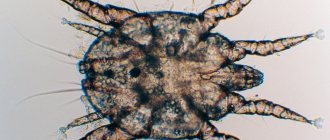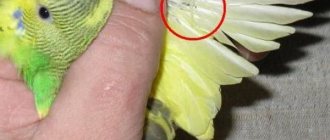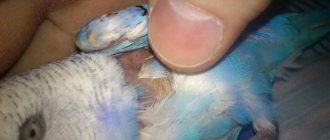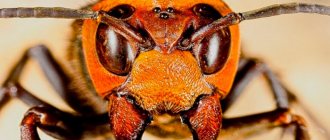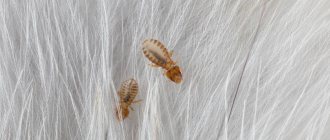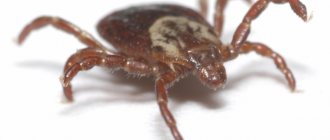Expert opinion
Dobryshev Sergey Anatolievich
Professional rabbit breeder and hare breeder with 30 years of experience
The scientific name for ear mites in rabbits is psoroptosis. This is a serious disease that is characterized by severe itching and causes severe discomfort to animals. The disease is progressive in nature, so when detected, it is necessary to urgently take effective measures.
Untimely treatment can lead to serious consequences, including the death of pets.
Psoroptosis in rabbits - what does an ear mite look like?
In rabbits, ear scabies are caused by a skin mite - psoroptes cuniculi. The dimensions of the parasite vary in the range of 0.5-0.9 mm, the body is yellow, sometimes with a shade of brown, and has the shape of a rounded oval.
It is difficult to see ticks with the naked eye; it is better to use a magnifying glass
The jaws are long and strong, which allows them to pierce the epidermis and suck out intracellular and tissue fluid. There are 4 pairs of legs along the edges.
The insect lives in the auricle of a rabbit , moving and piercing the skin, damaging tissue, irritating nerve receptors with bristles on the legs, which causes severe itching.
The condition of the epidermis is worsened by the toxic substance that ticks secrete when bitten, causing an allergic reaction.
As a result, the skin in the ear becomes inflamed, local nutrition is reduced, and restoration processes are disrupted.
Cells degenerate into keratinized scaly particles. Pathogenic organisms penetrate into the wounds, causing suppuration.
Important! Psoroptosis can occur at any time, but outbreaks of ear scabies in rabbits occur primarily during periods of cold weather.
All age groups are susceptible to the disease, the infection is more often detected in adults, and young animals and rabbits are less likely to get sick. Young animals become infected from their mother when the pathogen spreads from the rabbit’s ears to the offspring.
Possible ear diseases in rabbits
Diseases can be divided into contagious (tick-borne infestation) and non-contagious (otitis media, mechanical damage). The most common are several diseases:
- With ear scabies (otodectosis), the ear canals are affected. The causative agent of the disease is Otodectos mites, round in shape, 0.32-0.75 mm in size. If the parasite is not neutralized in time, pus forms and flows into the inner cavity of the ear. The infectious process spreads to the middle and inner ear, the meninges. Otodectosis most often affects rabbits older than 4 months;
- purulent otitis media is caused by bacteria and fungal infections. The inflammatory process develops behind the eardrum. An advanced disease leads to its destruction. Death is inevitable when the infection spreads throughout the body;
- Psoroptosis affects rabbits older than two months of age. The Psoroptes mite infects the inner surface of the ears, the auricles. Without treatment, the inflammatory process spreads to the neck, moves to the middle and inner ear and causes further complications in the form of meningitis.
Owners may also experience bleeding caused by scratching. The damaged area is treated with hydrogen peroxide and cauterized with alcohol and iodine. To prevent inflammation, the wound is lubricated with antiseptic ointment.
How do rabbits become infected with ear mites and how does it develop?
The source of infection is a rabbit infected with scabies; mites fall out of its ears along with peeled flakes of skin and scabs and move onto healthy animals.
Ear mites on a rabbit
Infection occurs:
- in close contact;
- through objects, bedding, feeders, owner’s clothes, equipment;
- when transplanting healthy rabbits into a room where sick individuals were kept.
In rare cases, cats or dogs that were accidentally infected in a dysfunctional household can carry insects.
Favorable factors for the development of the disease:
- cramped conditions in the cage;
- humidity;
- regrouping of animals;
- malnutrition.
Important! Latent carriage plays a significant role in the spread of infection, when adults and nymphs live in the outer ear of apparently healthy rabbits.
When an optimal environment arises for the continuation of the cycle, arthropod parasites are activated, which causes an outbreak of disease in the herd.
Be sure to read:
Common diseases in rabbits and how to treat them, photos, first symptoms, causes and prevention
Phases of development
When they penetrate the skin of the ear, mites begin to actively reproduce; one female reproduces up to 60 eggs, which are glued to the skin scales with uterine secretions.
The further life cycle includes the following development phases:
- Larva. It has 6 legs and emerges after an average of 4 days. Molting occurs after 2-3 days.
- Protonymph. This is the nymph of the next stage.
- Teleonympha. Preparatory stage for puberty.
- Imago. Males become mature 2 days earlier than females.
At sufficient temperature and humidity, development time for males is limited to 14 days, females mature in 16. The parasite lives on the skin of a rabbit for 2 months.
It is best to contact a veterinarian to confirm the diagnosis Hrunya.ru - your indispensable assistant on the farm
Males create copulatory pairs with female nymphs of the second phase, holding the insect with their legs. Fertilization occurs when the female emerges from the teleonymph's shell.
Infested ticks pose a danger in the spread of the disease.
This is interesting! The duration of the transformation phases from egg to adult insect is determined by the temperature and humidity of the environment. At +35°C and low humidity, the life cycle is extended to 55 days.
Treatment options
Treatment of ear mites in rabbits is carried out using acaricidal drugs, which have a detrimental effect on parasites. But in order for the therapy to give the desired result, it is necessary to clean the ears before administering the drugs, otherwise the accumulated wax will serve as a protective cocoon for mites.
It is necessary to moisten a cotton swab in any vegetable oil or hydrogen peroxide and thoroughly wipe the inside of the hearing organ with it. This will soften the crusts that have formed, remove sulfur and accumulated dirt. After this, the medicine should be administered. The procedure must be carried out with gloves.
In terms of how to treat rabbit ears, three groups of drugs should be distinguished:
- Drops (Stronghold, Dana Spot On, Mycodemocid). Any of these remedies should be dripped into each ear, 3-4 drops, and then massaged well for better distribution within the organ.
- Sprays ( Dicrazil, Psoroptol, Tsiodrin, Acrodex). Aerosols greatly simplify treatment. Spray against ear mites in rabbits should be sprayed on the inside of each ear from a distance of 10 cm for 5 seconds, and then massage them well.
- Injections (Acaromectin, Baymek, Ivermectin, Ivomek). This treatment method is used for severe forms of the disease when all other medications have not brought the desired result. Injections should only be done in consultation with your doctor. They must be injected subcutaneously into the withers area.
In addition to acaricidal drugs, the veterinarian can prescribe antibiotics to prevent the development of pathological processes in the animal’s body and immunomodulators to strengthen vitality.
Baymek
Is it only the scabies mite that lives in a rabbit's ears?
In rabbits, cutaneous parasites are localized and multiply directly in the ears, but sometimes they crawl onto the body and stay there for some time, and then move on to other animals.
Ticks are found on the skin of the neck and back, extremities with a strong spread, where they get due to scratching.
This is interesting! It is assumed that attachment to the habitat on the body of lagomorphs is associated with insignificant sweating in this area.
General information about ear scabies.
Ear scabies (otodectosis), caused by mites in rabbits, is not such a rare occurrence. Mostly adult animals get sick, but sometimes young animals are also affected, which are forced to come into contact with their mother, who is a carrier of ticks. The disease is widespread, although it causes great trouble for rabbit breeders in the southern regions, where persistent frosts are not observed. There is no particular danger to livestock at the initial stage of disease development. The rabbits seem to be generally healthy, eat food with appetite, grow, gain weight... However, not everything is as harmless as it seems at first glance. If measures are not taken to treat mange, the disease can affect the entire herd, and this, you see, is much more serious. The causative agents of the disease irritate the skin, causing infections and causing otitis media. Moreover, with advanced disease, not only the ears and other parts of the body are affected, but also the brain. Rabbits with a disease of the central nervous system are already a disaster.
How to understand that a rabbit has become infected with psoroptosis - ear mites
If a tick is detected, it is necessary to relieve the rabbit of itching, since scratching the ears not only promotes the spread of the tick, but also causes great discomfort to the animal.
Infection with the parasite causes discomfort, so the owner determines the infection by the following signs:
- pets often itch;
- rubs ears with front paws;
- shake their head;
- There is an increased accumulation of wax in the ears, which distinguishes the disease from frostbite.
Examination of the animal reveals scratching in the ear area, redness and nodules filled with fluid are noticeable in the ear canal.
Important! If the disease is asymptomatic, you can suspect the presence of a tick by looking at your pet's dirty ears.
Symptoms of rabbit ear scabies, psoroptosis without complications
The first signs of infection appear 1-14 days after the parasite gets on the rabbit's ears.
The first signs of infection appear 1-14 days after the parasite gets on the rabbit's ears. Insects irritate and damage the skin, and the response is an increase in the production of sebaceous glands, which leads to inflammation.
The course of a simple form resembles foci of weeping eczema, the disease is manifested by the following symptoms:
- severe itching: the animal itches, turns its head;
- small bumpy redness forms on the affected areas - a consequence of bites, then they turn into serous blisters;
- after a day or two, the vesicles burst, yellowish liquid flows out of them, forming grayish crusts when drying;
- The production of sulfur increases, it is concentrated in the ears in the form of brown-yellow lumps.
The condition of the rabbits is satisfactory, sometimes there is anxiety, loss of appetite, and females abandon their babies. Allergic responses in the form of rhinitis and lacrimation are possible.
Be sure to read:
Infectious stomatitis in rabbits: treatment of a wet muzzle, why biting midge is dangerous
If the symptoms are ignored, the animal's ear becomes covered with layers of scabs, sometimes blocking the ear canal.
Pathological changes penetrate the eardrum, causing purulent inflammation. In advanced cases, the process spreads to the neck, back, and limbs.
Important! The final diagnosis is made by a veterinarian based on microscopic examination of material from the affected area. To independently detect the presence of a parasite, you need to carefully remove part of the crust and skin scales from your pet’s ear, place it on a glass plate, and drop in Vaseline oil. When viewed with a magnifying glass, moving parasites are clearly visible.
Symptoms
This disease is very insidious because it is most often not detected immediately. However, if you are attentive to the animals on the farm, then ear scabies can be detected by some symptoms:
- the animal becomes more irritable and aggressive;
- Appetite is significantly reduced, so weight loss is observed;
- The rabbit often shakes its head from side to side.
If such symptoms appear, it is necessary to carefully examine the ears of the rabbits. If there are red blisters, this is a clear sign that the animal is suffering from tick bites.
Laboratory analysis of scraping the epidermis from the ear helps to accurately diagnose the disease.
Laboratory diagnostics can detect parasites and their eggs in scrapings taken from the animal’s ears. A similar study can be carried out without using a microscope: scrape a little skin from the surface of the inner part of the ear and stir it in warm (heated to 40 degrees) Vaseline oil - small arthropods will be visible under a magnifying glass.
You can learn about the main causes of psoroptosis and methods of its treatment from the following video:
The sooner the owner detects the disease in the rabbit, the faster and easier the treatment will be. In advanced cases, the process of ridding an animal of ear mites can take a long time. The lack of adequate treatment leads to the formation of a large number of scabs and hard crusts in the animal’s ears, which are an ideal environment for the development of harmful microorganisms.
The photo clearly shows what an advanced form of psoroptosis looks like in a rabbit
Treatment of ear mites in rabbits with folk remedies at home
In the treatment of the disease, folk recipes are used, the negative effect of which on insects is based on the influence of strong-smelling oily compounds.
A mixture of glycerin and iodine (alcohol solution) in a ratio of 1:4 is well suited for soaking scabs.
They soften scabs and crusts, and also prevent the parasite from breathing normally. Which methods are suitable for rabbits:
- Kerosene and any vegetable oil. The components are mixed in a ratio of 50:50. The composition is applied to the skin of the ears with a swab or syringe and massaged gently. The crusts are removed after softening.
- Oil and turpentine. The ratio of ingredients is 2:1, massage after treatment. Manipulations are repeated every 3 days until complete recovery.
- Camphor oil. The ears are treated daily, left for a few minutes and the scabs are removed.
- Glycerin and iodine solution. Stir ¼, the composition is intended for daily use.
Giving preference to traditional methods, it is worth assessing the effectiveness of treatment. For example, keep in mind that kerosene and turpentine irritate the animal’s skin, increasing discomfort.
The procedures require repeated use; if substances enter the ear canal, they can damage the hearing organs.
Perhaps, to eliminate mite infestation, it is better to use pharmaceutical products that are inexpensive, but more productive and faster in combating scabies.
How to treat scabies?
Rabbit scabies is one of the diseases that, fortunately, can be completely cured even without contacting a veterinarian. But you can use his advice right now. I give the floor to our permanent consultant IRINA TYLIK:
It needs to be treated with Amitrazine. First, soak the crusts in glycerin and iodine, clean the ear canal and instill amitrazine. Drip no more than once every 3 days, so as not to cause a burn. Before each instillation, you should clean your ears. Usually one treatment is sufficient. But if you see that there are residual effects, repeat the procedure. As a result, there should be no blackness or characteristic unpleasant odor left. With an advanced form of otodectosis, you can only see wounds left from tick bites. To guarantee and consolidate the result, moisten the ear canals with glycerin and iodine, remove the scabs from the wounds, and drip Amitrazine again.
Ears after treatment.
I want to share a method that an experienced rabbit breeder once advised me and which I later successfully used more than once. To implement it, you will only need kerosene or turpentine and vegetable oil. We prepare a solution consisting of equal parts of these components. Actually, the active part is turpentine, but in its pure form it can cause irritation to damaged skin. Then we wrap a small amount of cotton wool or gauze on a pre-made wooden splinter and generously lubricate the affected areas, while trying to massage the ears. We wait one day and conduct an inspection.
| Subscribe to our website's weekly newsletters: ✦ BROTHER RABBIT ✦ Current notes on keeping rabbits are waiting for you. SUBSCRIBE |
Even at the stage of the appearance of abundant crusts, the method works the first time. If you suddenly experience residual effects, you need to repeat the procedure after 2-3 days. A solution consisting of 1 part alcohol solution of iodine and 4 parts vegetable oil or glycerin works well.
It is more difficult to get rid of otodectosis in large farms with widespread or large-focal infection, since this requires simultaneous treatment of all animals and cells. Therefore, both treatment and prevention are best carried out in winter, at subzero air temperatures, when the survival rate of ticks outside the body of rabbits is minimal. Adult rabbits are given injections of Ivermec (1% Ivermectin solution) at the rate of 0.05 cubes per 1 kg of animal weight. This drug is good because it has a wide spectrum of action. At the same time, it copes with all types of helminths, fleas and other types of skin mites:
Ivermek cannot be used to treat young animals due to their low live weight. Therefore, more gentle drugs are used on them. For example, half a cube of ophthalmogel for several days in a row or Insektozol in the form of a spray, which is very convenient to use.
List of simple remedies for ear mites in rabbits
To treat an uncomplicated type of parasitic infestation and to prevent the disease, single-component acaricides are used - drugs created to kill arthropod insects.
Perhaps, to eliminate mite infestation, it is better to use pharmaceutical products that are inexpensive, but more productive and faster in combating scabies
The medicine is available in liquid solutions or aerosol cans, the method of use is indicated in the instructions, and the dosage is prescribed by a veterinarian.
The main requirement before use is to first clean the rabbit's ears from crusts so that the active substance has unhindered access to the skin and can fully exhibit its healing properties.
| A drug | Description | How to use | special instructions |
| Stronghold | A product based on selamectin, the solution is available in dosed pipettes | A drop of solution is applied to an area of skin | Do not use for pregnant females or rabbits |
| Aversectin ointment | The substance Aversectin-S is active against larvae and adults. The medicine has local and systemic effects | The frequency of treatment depends on the degree of damage: it is carried out 1-2 times, with an interval of a week or 5 days. For instillation into the ear, the composition can be melted | Not suitable for the treatment of pregnant and lactating females, rabbits up to 2 months, emaciated animals |
| Celandine Maximum | The insectoacaricidal agent is available in the form of a spray, the active ingredient is permethrin. Not absorbed into the bloodstream, but accumulates in the epithelium, wool, hair follicles and sebaceous glands | The dosage depends on the size of the rabbit, treatment is carried out 2 or 3 times, after 5-7 days | Not used for concomitant infectious diseases and perforation of the eardrum |
| Advocate | Drops for cats are suitable for rabbits; the drug contains imidacloprid and moxidectin | Apply once directly to the skin | The drug should not be instilled into the ears. The product is not recommended for young animals; pregnant and lactating rabbits should only be prescribed by a veterinarian |
| Acaromectin | The solution contains ivermectin | Treat ears twice every 10 days | Not used during reproduction, rabbits are allowed to use from 2 months |
| Dana Spot-on | The pipette tube contains fipronil, the compound is not absorbed into the bloodstream, accumulating in the skin, and remains active for up to one and a half months | The medicine is applied to the skin, treated at least 2 times, interval is a week | For rabbits, the drug is indicated from 4 months, for pregnant rabbits - under the supervision of a veterinarian |
| Mycodemocid | Contains chlorophos as an antiparasitic agent, sea buckthorn oil in its composition softens, and isopropyl alcohol disinfects the skin. | Apply a thin layer at intervals of 5-7 days until recovery | The solution is contraindicated in pregnant and lactating females; it is prescribed to young animals from 2 months |
| Butox | Concentrated emulsion is intended for treating premises and animals, suitable for large farms | For the treatment of ears, the dose is 1 ml of the drug per 1 liter of cool water. | During pregnancy, the solution is approved for use |
Important! If after a single treatment the symptoms of the disease have disappeared, do not stop treatment. The active substance of any acaricide is effective only against larvae and adults; it does not affect eggs; repeated application of the medicine is required to eliminate newly hatched parasites.
Prevention of ear psoroptosis in rabbits
To prevent the development of psoroptosis on a rabbit farm and in an apartment, it is important to follow preventive measures, which include compliance with sanitary rules and animal hygiene standards.
Be sure to read:
Eye diseases in rabbits: how and what to treat at home
This requires:
- Carry out regular inspection of rabbits' ears for the presence of parasites;
- isolate the animal if infection is detected or if infection is suspected;
- purchase livestock only from disease-free farms;
- keep animals in quarantine for at least a month, during this period examine them for psoroptosis;
- carry out disinfection in cages and rooms where rabbits live at least once every 6 months, as well as process equipment and disinfect clothing.
In order to prevent infection of the young, healthy males are selected for mating, and the rabbit’s ears are examined 2 weeks before giving birth.
If an infection is detected, the area is treated with a local antiparasitic agent as recommended by a veterinarian.
Diagnostics
A sick pet should be taken to the veterinarian. He will take a scraping from the animal's ears and determine the presence of a tick in them. It can be easily examined with a microscope and even through a magnifying glass. If it is not possible to go to a clinic, test for psoroptosis at home. For this you will need:
- clean glass;
- cotton swab;
- Vaseline oil;
- magnifying glass
With the help of someone close to you, secure the rabbit so that it cannot escape and jerk its head while taking biomaterial. With one hand, open the ear, and with the other, use a cotton swab to remove a small piece of wax. Heat the Vaseline oil in a water bath or radiator to a temperature of 40 degrees. Take a little oil and apply it to the glass, then place the biomaterial for research on the greasy stain. In good lighting, look at it through a magnifying glass. In the mass taken from the pet's ear, you can see both adult mites and their eggs.
Checking a rabbit's ears at the veterinarian
